Organizational Change and Leadership: Aldi vs. M&S Analysis
VerifiedAdded on 2020/09/17
|13
|3970
|265
Report
AI Summary
This report delves into the complexities of organizational change and leadership, using Aldi and M&S as case studies. It examines the impact of internal and external drivers on leadership, team dynamics, and individual behavior within these retail giants. The report explores how these companies adapt their strategies and operations to navigate market shifts, including discussions on organizational culture, resistance to change, and the importance of effective teamwork. It also analyzes measures to mitigate the negative impacts of change, such as training programs and technological advancements, and identifies barriers to change influencing leadership decisions. Furthermore, the report evaluates leadership approaches, including the application of the McKinsey 7-S model, to address change effectively within the organizational context of Aldi. The report aims to provide a comprehensive understanding of change management strategies and leadership practices in the retail sector.
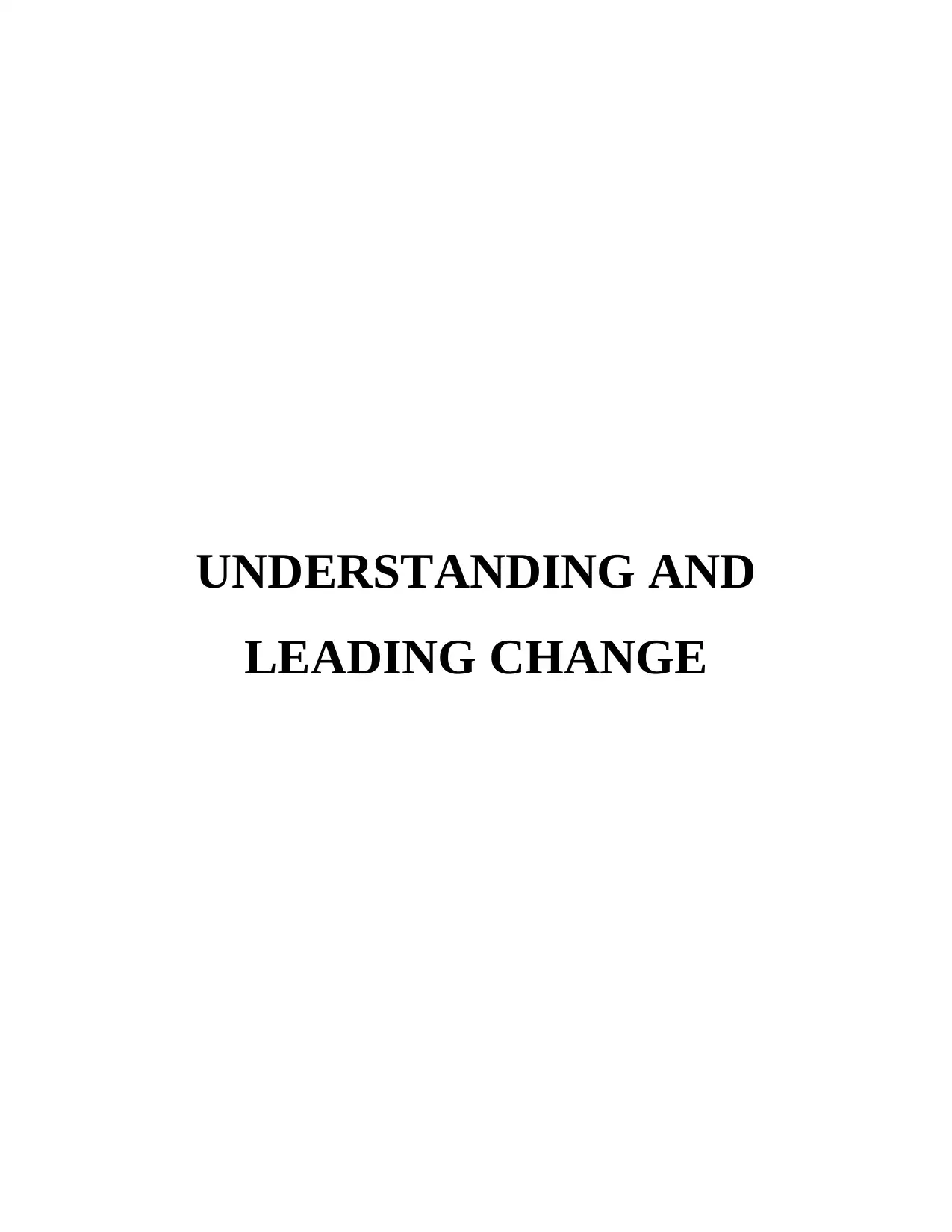
UNDERSTANDING AND
LEADING CHANGE
LEADING CHANGE
Paraphrase This Document
Need a fresh take? Get an instant paraphrase of this document with our AI Paraphraser
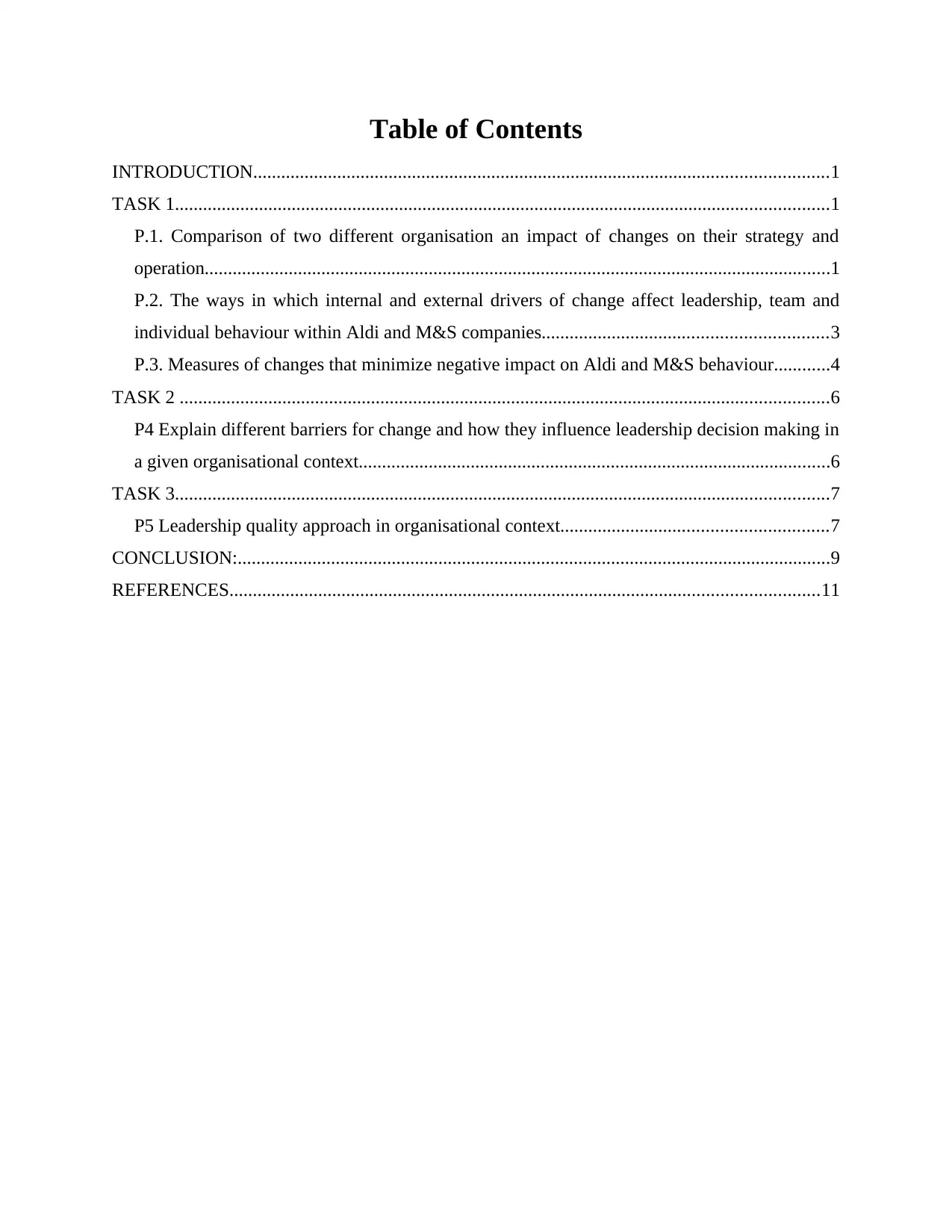
Table of Contents
INTRODUCTION...........................................................................................................................1
TASK 1............................................................................................................................................1
P.1. Comparison of two different organisation an impact of changes on their strategy and
operation......................................................................................................................................1
P.2. The ways in which internal and external drivers of change affect leadership, team and
individual behaviour within Aldi and M&S companies.............................................................3
P.3. Measures of changes that minimize negative impact on Aldi and M&S behaviour............4
TASK 2 ...........................................................................................................................................6
P4 Explain different barriers for change and how they influence leadership decision making in
a given organisational context.....................................................................................................6
TASK 3............................................................................................................................................7
P5 Leadership quality approach in organisational context.........................................................7
CONCLUSION:...............................................................................................................................9
REFERENCES..............................................................................................................................11
INTRODUCTION...........................................................................................................................1
TASK 1............................................................................................................................................1
P.1. Comparison of two different organisation an impact of changes on their strategy and
operation......................................................................................................................................1
P.2. The ways in which internal and external drivers of change affect leadership, team and
individual behaviour within Aldi and M&S companies.............................................................3
P.3. Measures of changes that minimize negative impact on Aldi and M&S behaviour............4
TASK 2 ...........................................................................................................................................6
P4 Explain different barriers for change and how they influence leadership decision making in
a given organisational context.....................................................................................................6
TASK 3............................................................................................................................................7
P5 Leadership quality approach in organisational context.........................................................7
CONCLUSION:...............................................................................................................................9
REFERENCES..............................................................................................................................11
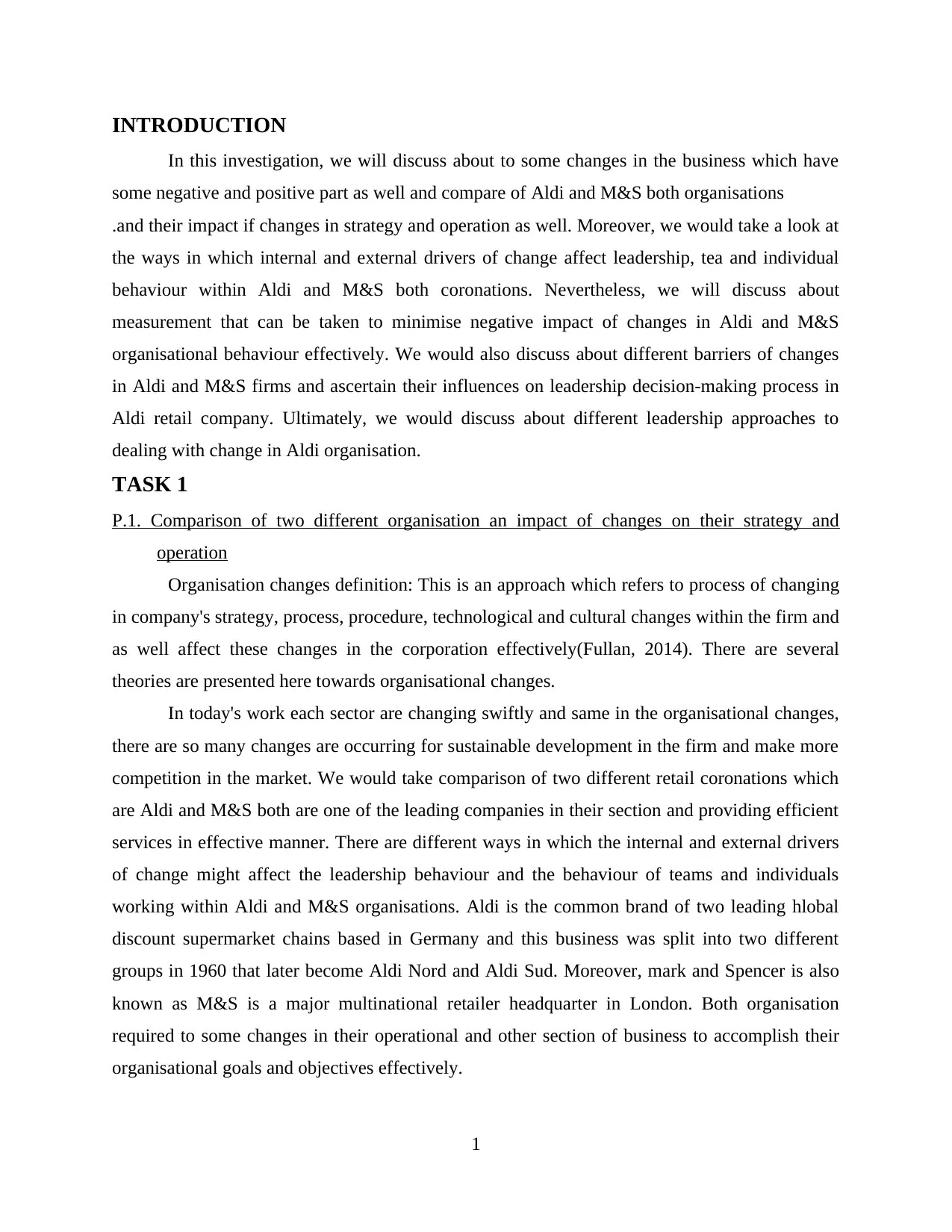
INTRODUCTION
In this investigation, we will discuss about to some changes in the business which have
some negative and positive part as well and compare of Aldi and M&S both organisations
.and their impact if changes in strategy and operation as well. Moreover, we would take a look at
the ways in which internal and external drivers of change affect leadership, tea and individual
behaviour within Aldi and M&S both coronations. Nevertheless, we will discuss about
measurement that can be taken to minimise negative impact of changes in Aldi and M&S
organisational behaviour effectively. We would also discuss about different barriers of changes
in Aldi and M&S firms and ascertain their influences on leadership decision-making process in
Aldi retail company. Ultimately, we would discuss about different leadership approaches to
dealing with change in Aldi organisation.
TASK 1
P.1. Comparison of two different organisation an impact of changes on their strategy and
operation
Organisation changes definition: This is an approach which refers to process of changing
in company's strategy, process, procedure, technological and cultural changes within the firm and
as well affect these changes in the corporation effectively(Fullan, 2014). There are several
theories are presented here towards organisational changes.
In today's work each sector are changing swiftly and same in the organisational changes,
there are so many changes are occurring for sustainable development in the firm and make more
competition in the market. We would take comparison of two different retail coronations which
are Aldi and M&S both are one of the leading companies in their section and providing efficient
services in effective manner. There are different ways in which the internal and external drivers
of change might affect the leadership behaviour and the behaviour of teams and individuals
working within Aldi and M&S organisations. Aldi is the common brand of two leading hlobal
discount supermarket chains based in Germany and this business was split into two different
groups in 1960 that later become Aldi Nord and Aldi Sud. Moreover, mark and Spencer is also
known as M&S is a major multinational retailer headquarter in London. Both organisation
required to some changes in their operational and other section of business to accomplish their
organisational goals and objectives effectively.
1
In this investigation, we will discuss about to some changes in the business which have
some negative and positive part as well and compare of Aldi and M&S both organisations
.and their impact if changes in strategy and operation as well. Moreover, we would take a look at
the ways in which internal and external drivers of change affect leadership, tea and individual
behaviour within Aldi and M&S both coronations. Nevertheless, we will discuss about
measurement that can be taken to minimise negative impact of changes in Aldi and M&S
organisational behaviour effectively. We would also discuss about different barriers of changes
in Aldi and M&S firms and ascertain their influences on leadership decision-making process in
Aldi retail company. Ultimately, we would discuss about different leadership approaches to
dealing with change in Aldi organisation.
TASK 1
P.1. Comparison of two different organisation an impact of changes on their strategy and
operation
Organisation changes definition: This is an approach which refers to process of changing
in company's strategy, process, procedure, technological and cultural changes within the firm and
as well affect these changes in the corporation effectively(Fullan, 2014). There are several
theories are presented here towards organisational changes.
In today's work each sector are changing swiftly and same in the organisational changes,
there are so many changes are occurring for sustainable development in the firm and make more
competition in the market. We would take comparison of two different retail coronations which
are Aldi and M&S both are one of the leading companies in their section and providing efficient
services in effective manner. There are different ways in which the internal and external drivers
of change might affect the leadership behaviour and the behaviour of teams and individuals
working within Aldi and M&S organisations. Aldi is the common brand of two leading hlobal
discount supermarket chains based in Germany and this business was split into two different
groups in 1960 that later become Aldi Nord and Aldi Sud. Moreover, mark and Spencer is also
known as M&S is a major multinational retailer headquarter in London. Both organisation
required to some changes in their operational and other section of business to accomplish their
organisational goals and objectives effectively.
1
⊘ This is a preview!⊘
Do you want full access?
Subscribe today to unlock all pages.

Trusted by 1+ million students worldwide
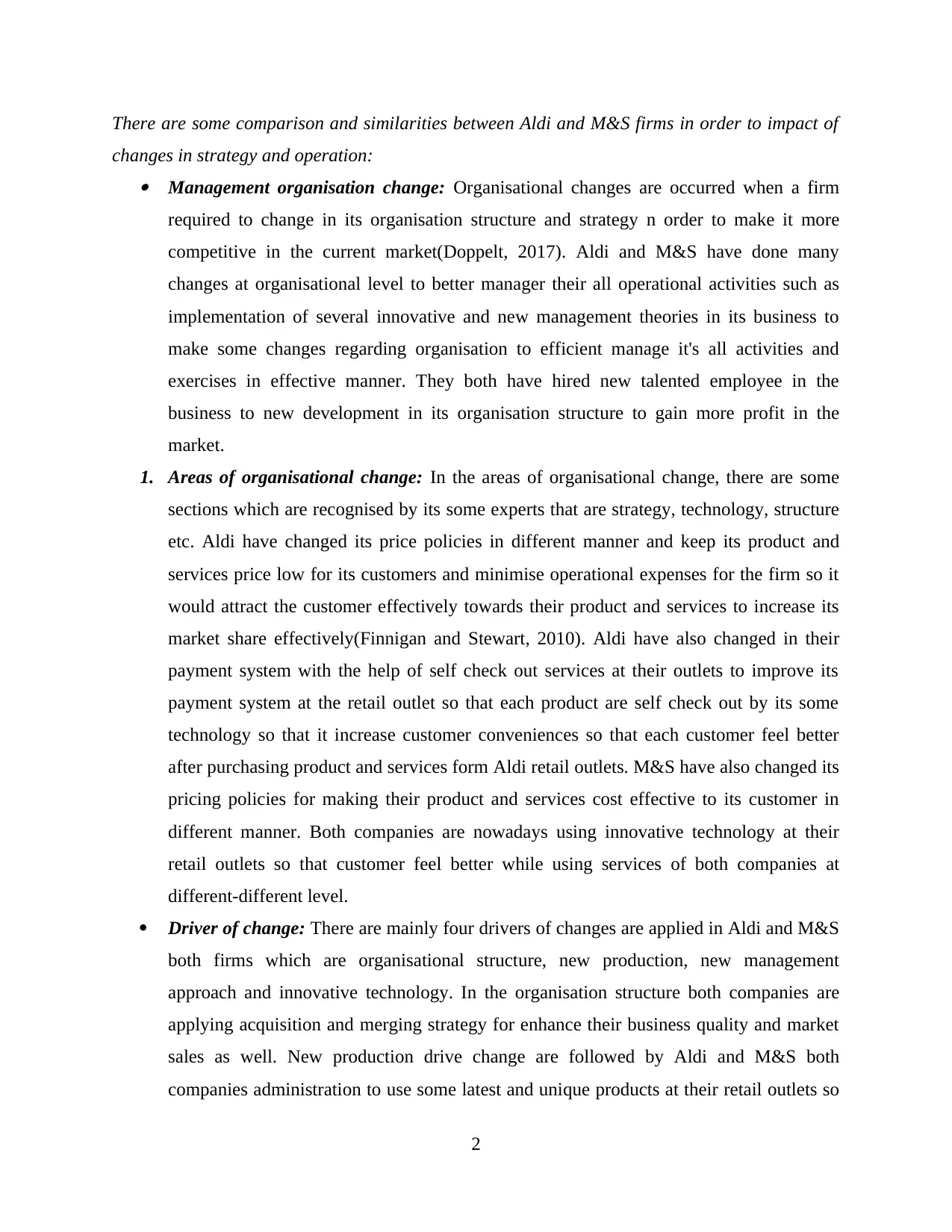
There are some comparison and similarities between Aldi and M&S firms in order to impact of
changes in strategy and operation: Management organisation change: Organisational changes are occurred when a firm
required to change in its organisation structure and strategy n order to make it more
competitive in the current market(Doppelt, 2017). Aldi and M&S have done many
changes at organisational level to better manager their all operational activities such as
implementation of several innovative and new management theories in its business to
make some changes regarding organisation to efficient manage it's all activities and
exercises in effective manner. They both have hired new talented employee in the
business to new development in its organisation structure to gain more profit in the
market.
1. Areas of organisational change: In the areas of organisational change, there are some
sections which are recognised by its some experts that are strategy, technology, structure
etc. Aldi have changed its price policies in different manner and keep its product and
services price low for its customers and minimise operational expenses for the firm so it
would attract the customer effectively towards their product and services to increase its
market share effectively(Finnigan and Stewart, 2010). Aldi have also changed in their
payment system with the help of self check out services at their outlets to improve its
payment system at the retail outlet so that each product are self check out by its some
technology so that it increase customer conveniences so that each customer feel better
after purchasing product and services form Aldi retail outlets. M&S have also changed its
pricing policies for making their product and services cost effective to its customer in
different manner. Both companies are nowadays using innovative technology at their
retail outlets so that customer feel better while using services of both companies at
different-different level.
Driver of change: There are mainly four drivers of changes are applied in Aldi and M&S
both firms which are organisational structure, new production, new management
approach and innovative technology. In the organisation structure both companies are
applying acquisition and merging strategy for enhance their business quality and market
sales as well. New production drive change are followed by Aldi and M&S both
companies administration to use some latest and unique products at their retail outlets so
2
changes in strategy and operation: Management organisation change: Organisational changes are occurred when a firm
required to change in its organisation structure and strategy n order to make it more
competitive in the current market(Doppelt, 2017). Aldi and M&S have done many
changes at organisational level to better manager their all operational activities such as
implementation of several innovative and new management theories in its business to
make some changes regarding organisation to efficient manage it's all activities and
exercises in effective manner. They both have hired new talented employee in the
business to new development in its organisation structure to gain more profit in the
market.
1. Areas of organisational change: In the areas of organisational change, there are some
sections which are recognised by its some experts that are strategy, technology, structure
etc. Aldi have changed its price policies in different manner and keep its product and
services price low for its customers and minimise operational expenses for the firm so it
would attract the customer effectively towards their product and services to increase its
market share effectively(Finnigan and Stewart, 2010). Aldi have also changed in their
payment system with the help of self check out services at their outlets to improve its
payment system at the retail outlet so that each product are self check out by its some
technology so that it increase customer conveniences so that each customer feel better
after purchasing product and services form Aldi retail outlets. M&S have also changed its
pricing policies for making their product and services cost effective to its customer in
different manner. Both companies are nowadays using innovative technology at their
retail outlets so that customer feel better while using services of both companies at
different-different level.
Driver of change: There are mainly four drivers of changes are applied in Aldi and M&S
both firms which are organisational structure, new production, new management
approach and innovative technology. In the organisation structure both companies are
applying acquisition and merging strategy for enhance their business quality and market
sales as well. New production drive change are followed by Aldi and M&S both
companies administration to use some latest and unique products at their retail outlets so
2
Paraphrase This Document
Need a fresh take? Get an instant paraphrase of this document with our AI Paraphraser
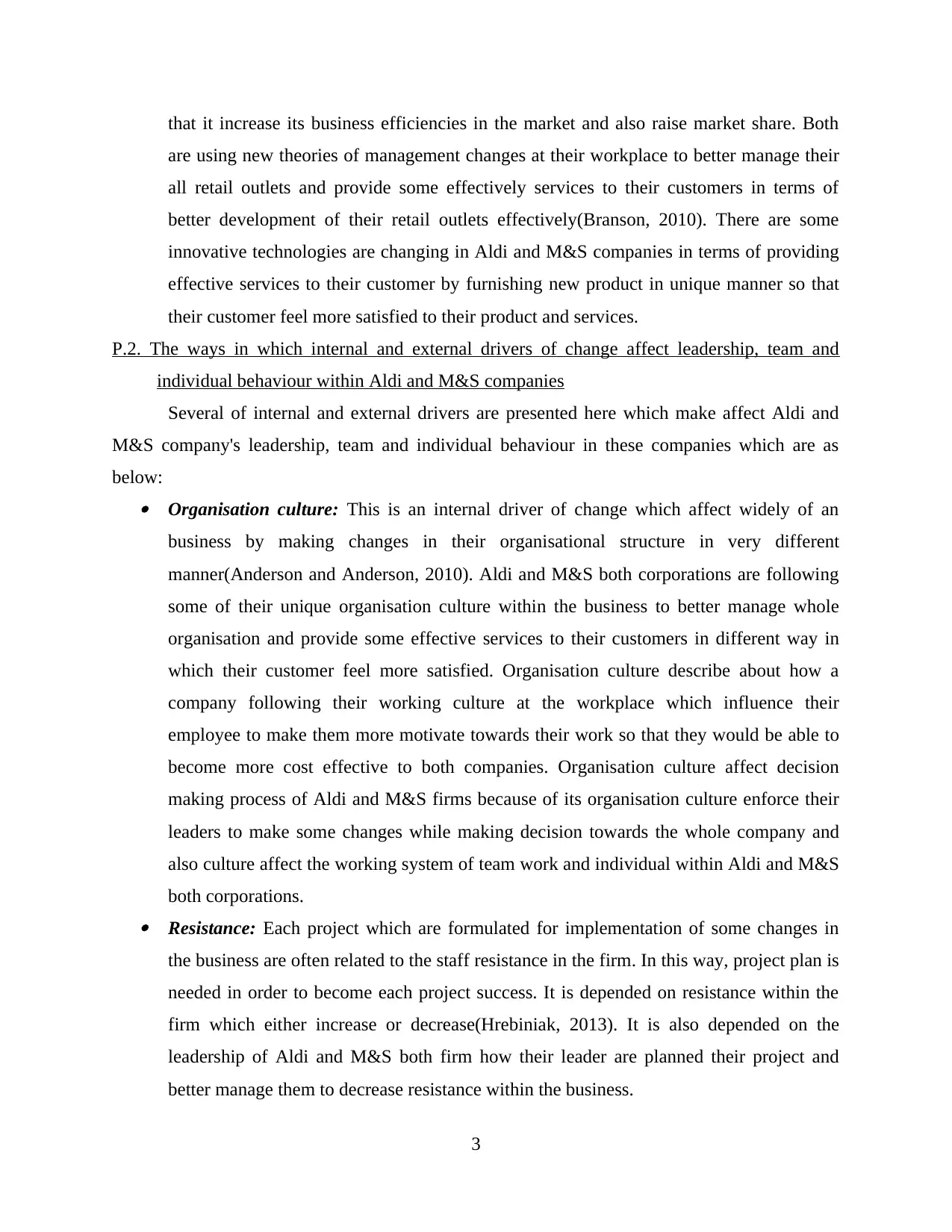
that it increase its business efficiencies in the market and also raise market share. Both
are using new theories of management changes at their workplace to better manage their
all retail outlets and provide some effectively services to their customers in terms of
better development of their retail outlets effectively(Branson, 2010). There are some
innovative technologies are changing in Aldi and M&S companies in terms of providing
effective services to their customer by furnishing new product in unique manner so that
their customer feel more satisfied to their product and services.
P.2. The ways in which internal and external drivers of change affect leadership, team and
individual behaviour within Aldi and M&S companies
Several of internal and external drivers are presented here which make affect Aldi and
M&S company's leadership, team and individual behaviour in these companies which are as
below: Organisation culture: This is an internal driver of change which affect widely of an
business by making changes in their organisational structure in very different
manner(Anderson and Anderson, 2010). Aldi and M&S both corporations are following
some of their unique organisation culture within the business to better manage whole
organisation and provide some effective services to their customers in different way in
which their customer feel more satisfied. Organisation culture describe about how a
company following their working culture at the workplace which influence their
employee to make them more motivate towards their work so that they would be able to
become more cost effective to both companies. Organisation culture affect decision
making process of Aldi and M&S firms because of its organisation culture enforce their
leaders to make some changes while making decision towards the whole company and
also culture affect the working system of team work and individual within Aldi and M&S
both corporations. Resistance: Each project which are formulated for implementation of some changes in
the business are often related to the staff resistance in the firm. In this way, project plan is
needed in order to become each project success. It is depended on resistance within the
firm which either increase or decrease(Hrebiniak, 2013). It is also depended on the
leadership of Aldi and M&S both firm how their leader are planned their project and
better manage them to decrease resistance within the business.
3
are using new theories of management changes at their workplace to better manage their
all retail outlets and provide some effectively services to their customers in terms of
better development of their retail outlets effectively(Branson, 2010). There are some
innovative technologies are changing in Aldi and M&S companies in terms of providing
effective services to their customer by furnishing new product in unique manner so that
their customer feel more satisfied to their product and services.
P.2. The ways in which internal and external drivers of change affect leadership, team and
individual behaviour within Aldi and M&S companies
Several of internal and external drivers are presented here which make affect Aldi and
M&S company's leadership, team and individual behaviour in these companies which are as
below: Organisation culture: This is an internal driver of change which affect widely of an
business by making changes in their organisational structure in very different
manner(Anderson and Anderson, 2010). Aldi and M&S both corporations are following
some of their unique organisation culture within the business to better manage whole
organisation and provide some effective services to their customers in different way in
which their customer feel more satisfied. Organisation culture describe about how a
company following their working culture at the workplace which influence their
employee to make them more motivate towards their work so that they would be able to
become more cost effective to both companies. Organisation culture affect decision
making process of Aldi and M&S firms because of its organisation culture enforce their
leaders to make some changes while making decision towards the whole company and
also culture affect the working system of team work and individual within Aldi and M&S
both corporations. Resistance: Each project which are formulated for implementation of some changes in
the business are often related to the staff resistance in the firm. In this way, project plan is
needed in order to become each project success. It is depended on resistance within the
firm which either increase or decrease(Hrebiniak, 2013). It is also depended on the
leadership of Aldi and M&S both firm how their leader are planned their project and
better manage them to decrease resistance within the business.
3
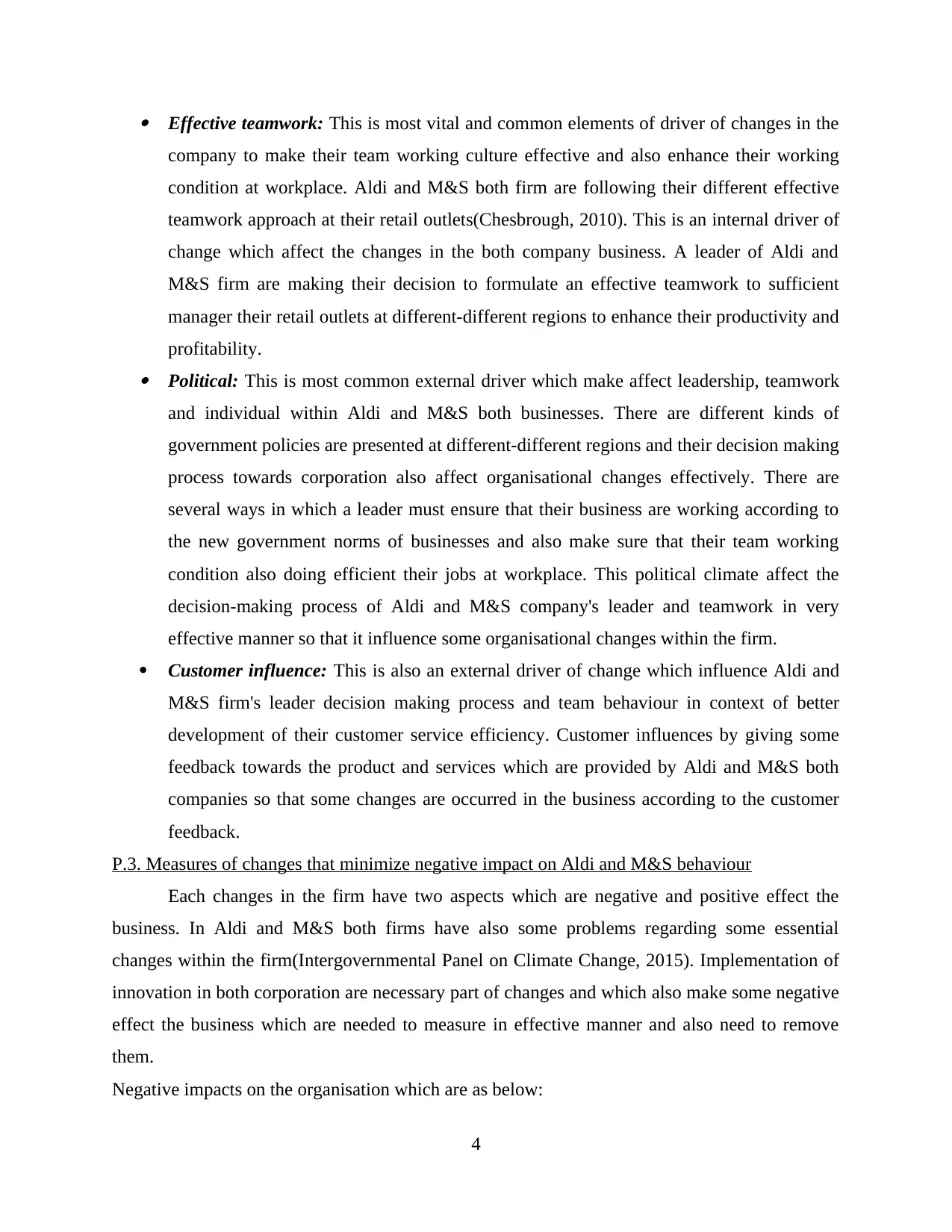
Effective teamwork: This is most vital and common elements of driver of changes in the
company to make their team working culture effective and also enhance their working
condition at workplace. Aldi and M&S both firm are following their different effective
teamwork approach at their retail outlets(Chesbrough, 2010). This is an internal driver of
change which affect the changes in the both company business. A leader of Aldi and
M&S firm are making their decision to formulate an effective teamwork to sufficient
manager their retail outlets at different-different regions to enhance their productivity and
profitability. Political: This is most common external driver which make affect leadership, teamwork
and individual within Aldi and M&S both businesses. There are different kinds of
government policies are presented at different-different regions and their decision making
process towards corporation also affect organisational changes effectively. There are
several ways in which a leader must ensure that their business are working according to
the new government norms of businesses and also make sure that their team working
condition also doing efficient their jobs at workplace. This political climate affect the
decision-making process of Aldi and M&S company's leader and teamwork in very
effective manner so that it influence some organisational changes within the firm.
Customer influence: This is also an external driver of change which influence Aldi and
M&S firm's leader decision making process and team behaviour in context of better
development of their customer service efficiency. Customer influences by giving some
feedback towards the product and services which are provided by Aldi and M&S both
companies so that some changes are occurred in the business according to the customer
feedback.
P.3. Measures of changes that minimize negative impact on Aldi and M&S behaviour
Each changes in the firm have two aspects which are negative and positive effect the
business. In Aldi and M&S both firms have also some problems regarding some essential
changes within the firm(Intergovernmental Panel on Climate Change, 2015). Implementation of
innovation in both corporation are necessary part of changes and which also make some negative
effect the business which are needed to measure in effective manner and also need to remove
them.
Negative impacts on the organisation which are as below:
4
company to make their team working culture effective and also enhance their working
condition at workplace. Aldi and M&S both firm are following their different effective
teamwork approach at their retail outlets(Chesbrough, 2010). This is an internal driver of
change which affect the changes in the both company business. A leader of Aldi and
M&S firm are making their decision to formulate an effective teamwork to sufficient
manager their retail outlets at different-different regions to enhance their productivity and
profitability. Political: This is most common external driver which make affect leadership, teamwork
and individual within Aldi and M&S both businesses. There are different kinds of
government policies are presented at different-different regions and their decision making
process towards corporation also affect organisational changes effectively. There are
several ways in which a leader must ensure that their business are working according to
the new government norms of businesses and also make sure that their team working
condition also doing efficient their jobs at workplace. This political climate affect the
decision-making process of Aldi and M&S company's leader and teamwork in very
effective manner so that it influence some organisational changes within the firm.
Customer influence: This is also an external driver of change which influence Aldi and
M&S firm's leader decision making process and team behaviour in context of better
development of their customer service efficiency. Customer influences by giving some
feedback towards the product and services which are provided by Aldi and M&S both
companies so that some changes are occurred in the business according to the customer
feedback.
P.3. Measures of changes that minimize negative impact on Aldi and M&S behaviour
Each changes in the firm have two aspects which are negative and positive effect the
business. In Aldi and M&S both firms have also some problems regarding some essential
changes within the firm(Intergovernmental Panel on Climate Change, 2015). Implementation of
innovation in both corporation are necessary part of changes and which also make some negative
effect the business which are needed to measure in effective manner and also need to remove
them.
Negative impacts on the organisation which are as below:
4
⊘ This is a preview!⊘
Do you want full access?
Subscribe today to unlock all pages.

Trusted by 1+ million students worldwide
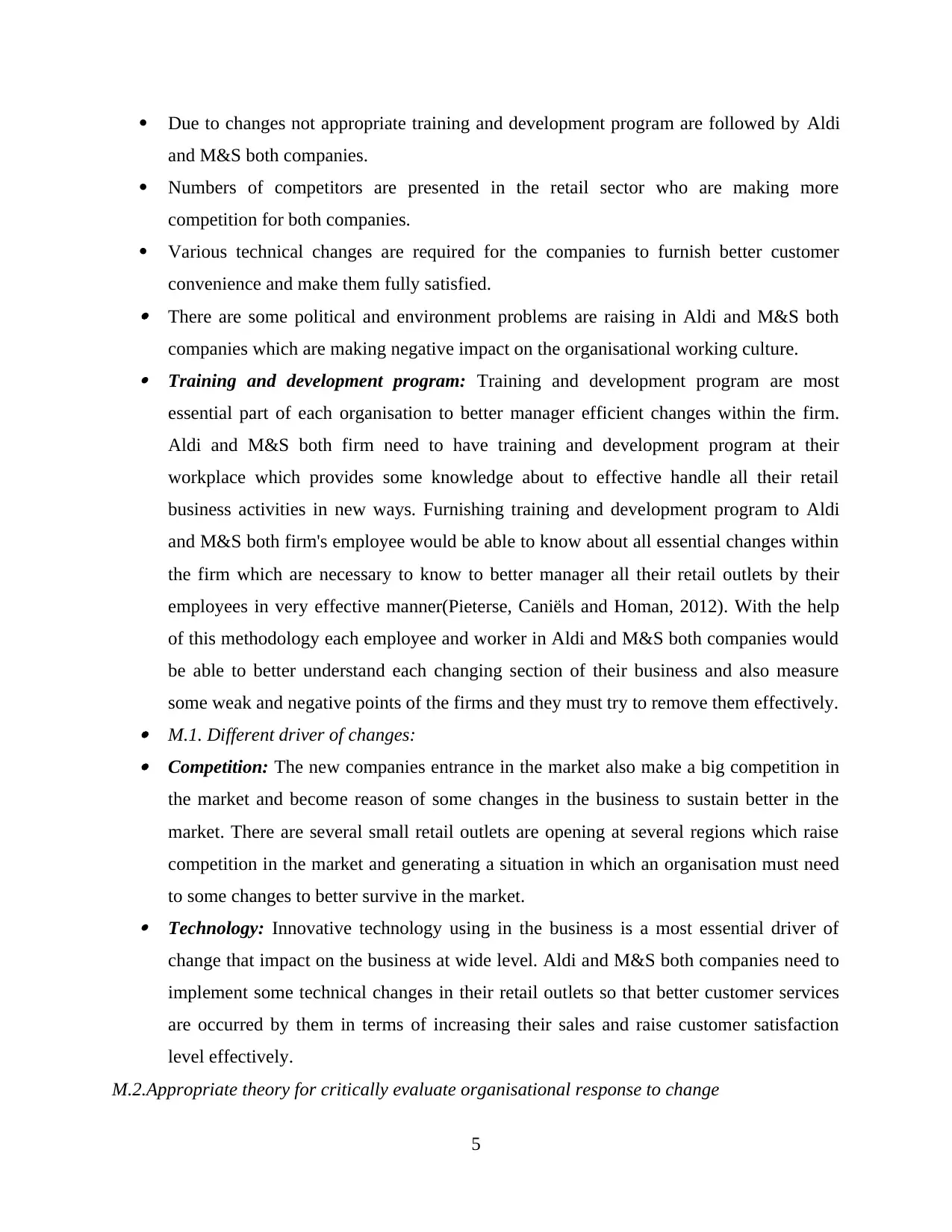
Due to changes not appropriate training and development program are followed by Aldi
and M&S both companies.
Numbers of competitors are presented in the retail sector who are making more
competition for both companies.
Various technical changes are required for the companies to furnish better customer
convenience and make them fully satisfied. There are some political and environment problems are raising in Aldi and M&S both
companies which are making negative impact on the organisational working culture. Training and development program: Training and development program are most
essential part of each organisation to better manager efficient changes within the firm.
Aldi and M&S both firm need to have training and development program at their
workplace which provides some knowledge about to effective handle all their retail
business activities in new ways. Furnishing training and development program to Aldi
and M&S both firm's employee would be able to know about all essential changes within
the firm which are necessary to know to better manager all their retail outlets by their
employees in very effective manner(Pieterse, Caniëls and Homan, 2012). With the help
of this methodology each employee and worker in Aldi and M&S both companies would
be able to better understand each changing section of their business and also measure
some weak and negative points of the firms and they must try to remove them effectively. M.1. Different driver of changes: Competition: The new companies entrance in the market also make a big competition in
the market and become reason of some changes in the business to sustain better in the
market. There are several small retail outlets are opening at several regions which raise
competition in the market and generating a situation in which an organisation must need
to some changes to better survive in the market. Technology: Innovative technology using in the business is a most essential driver of
change that impact on the business at wide level. Aldi and M&S both companies need to
implement some technical changes in their retail outlets so that better customer services
are occurred by them in terms of increasing their sales and raise customer satisfaction
level effectively.
M.2.Appropriate theory for critically evaluate organisational response to change
5
and M&S both companies.
Numbers of competitors are presented in the retail sector who are making more
competition for both companies.
Various technical changes are required for the companies to furnish better customer
convenience and make them fully satisfied. There are some political and environment problems are raising in Aldi and M&S both
companies which are making negative impact on the organisational working culture. Training and development program: Training and development program are most
essential part of each organisation to better manager efficient changes within the firm.
Aldi and M&S both firm need to have training and development program at their
workplace which provides some knowledge about to effective handle all their retail
business activities in new ways. Furnishing training and development program to Aldi
and M&S both firm's employee would be able to know about all essential changes within
the firm which are necessary to know to better manager all their retail outlets by their
employees in very effective manner(Pieterse, Caniëls and Homan, 2012). With the help
of this methodology each employee and worker in Aldi and M&S both companies would
be able to better understand each changing section of their business and also measure
some weak and negative points of the firms and they must try to remove them effectively. M.1. Different driver of changes: Competition: The new companies entrance in the market also make a big competition in
the market and become reason of some changes in the business to sustain better in the
market. There are several small retail outlets are opening at several regions which raise
competition in the market and generating a situation in which an organisation must need
to some changes to better survive in the market. Technology: Innovative technology using in the business is a most essential driver of
change that impact on the business at wide level. Aldi and M&S both companies need to
implement some technical changes in their retail outlets so that better customer services
are occurred by them in terms of increasing their sales and raise customer satisfaction
level effectively.
M.2.Appropriate theory for critically evaluate organisational response to change
5
Paraphrase This Document
Need a fresh take? Get an instant paraphrase of this document with our AI Paraphraser
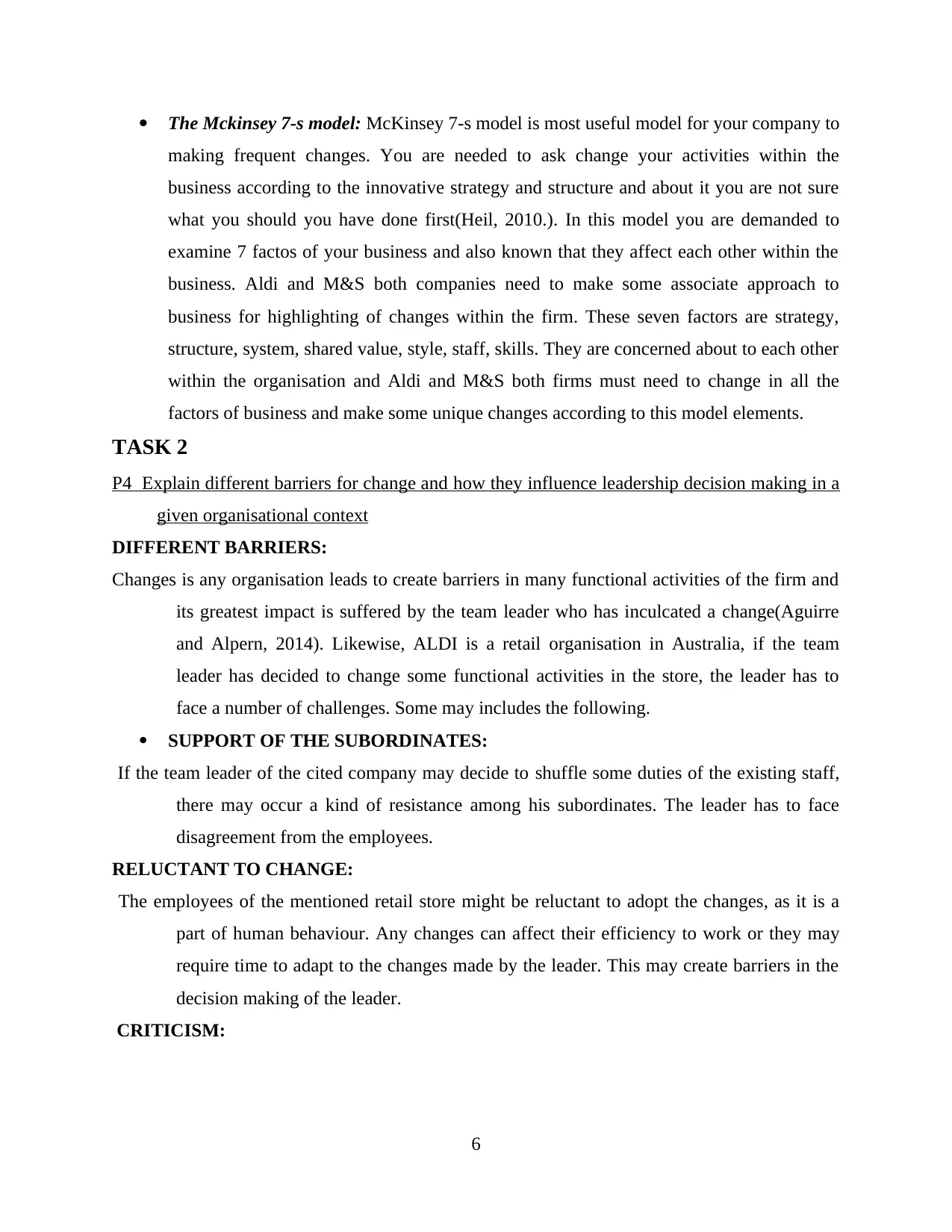
The Mckinsey 7-s model: McKinsey 7-s model is most useful model for your company to
making frequent changes. You are needed to ask change your activities within the
business according to the innovative strategy and structure and about it you are not sure
what you should you have done first(Heil, 2010.). In this model you are demanded to
examine 7 factos of your business and also known that they affect each other within the
business. Aldi and M&S both companies need to make some associate approach to
business for highlighting of changes within the firm. These seven factors are strategy,
structure, system, shared value, style, staff, skills. They are concerned about to each other
within the organisation and Aldi and M&S both firms must need to change in all the
factors of business and make some unique changes according to this model elements.
TASK 2
P4 Explain different barriers for change and how they influence leadership decision making in a
given organisational context
DIFFERENT BARRIERS:
Changes is any organisation leads to create barriers in many functional activities of the firm and
its greatest impact is suffered by the team leader who has inculcated a change(Aguirre
and Alpern, 2014). Likewise, ALDI is a retail organisation in Australia, if the team
leader has decided to change some functional activities in the store, the leader has to
face a number of challenges. Some may includes the following.
SUPPORT OF THE SUBORDINATES:
If the team leader of the cited company may decide to shuffle some duties of the existing staff,
there may occur a kind of resistance among his subordinates. The leader has to face
disagreement from the employees.
RELUCTANT TO CHANGE:
The employees of the mentioned retail store might be reluctant to adopt the changes, as it is a
part of human behaviour. Any changes can affect their efficiency to work or they may
require time to adapt to the changes made by the leader. This may create barriers in the
decision making of the leader.
CRITICISM:
6
making frequent changes. You are needed to ask change your activities within the
business according to the innovative strategy and structure and about it you are not sure
what you should you have done first(Heil, 2010.). In this model you are demanded to
examine 7 factos of your business and also known that they affect each other within the
business. Aldi and M&S both companies need to make some associate approach to
business for highlighting of changes within the firm. These seven factors are strategy,
structure, system, shared value, style, staff, skills. They are concerned about to each other
within the organisation and Aldi and M&S both firms must need to change in all the
factors of business and make some unique changes according to this model elements.
TASK 2
P4 Explain different barriers for change and how they influence leadership decision making in a
given organisational context
DIFFERENT BARRIERS:
Changes is any organisation leads to create barriers in many functional activities of the firm and
its greatest impact is suffered by the team leader who has inculcated a change(Aguirre
and Alpern, 2014). Likewise, ALDI is a retail organisation in Australia, if the team
leader has decided to change some functional activities in the store, the leader has to
face a number of challenges. Some may includes the following.
SUPPORT OF THE SUBORDINATES:
If the team leader of the cited company may decide to shuffle some duties of the existing staff,
there may occur a kind of resistance among his subordinates. The leader has to face
disagreement from the employees.
RELUCTANT TO CHANGE:
The employees of the mentioned retail store might be reluctant to adopt the changes, as it is a
part of human behaviour. Any changes can affect their efficiency to work or they may
require time to adapt to the changes made by the leader. This may create barriers in the
decision making of the leader.
CRITICISM:
6
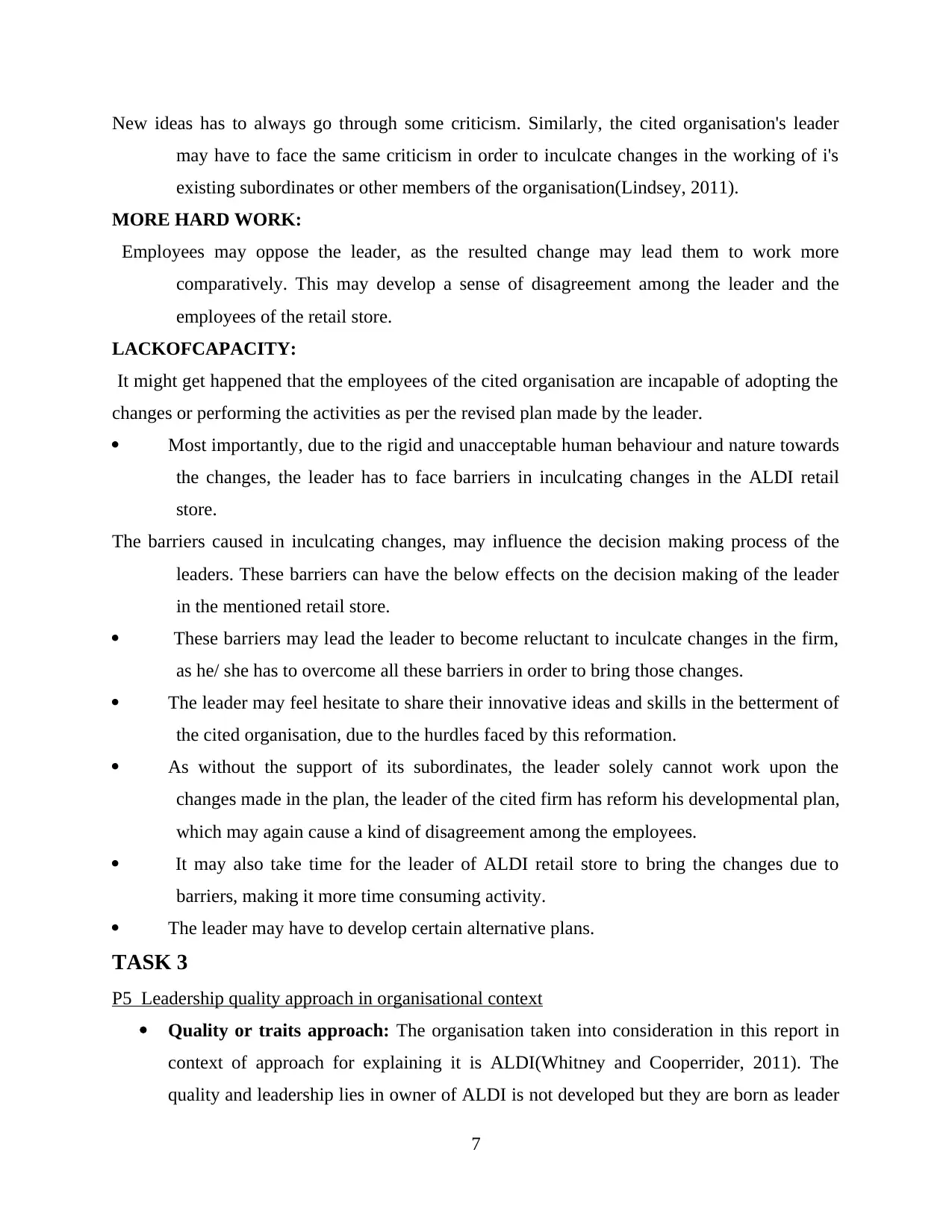
New ideas has to always go through some criticism. Similarly, the cited organisation's leader
may have to face the same criticism in order to inculcate changes in the working of i's
existing subordinates or other members of the organisation(Lindsey, 2011).
MORE HARD WORK:
Employees may oppose the leader, as the resulted change may lead them to work more
comparatively. This may develop a sense of disagreement among the leader and the
employees of the retail store.
LACKOFCAPACITY:
It might get happened that the employees of the cited organisation are incapable of adopting the
changes or performing the activities as per the revised plan made by the leader.
Most importantly, due to the rigid and unacceptable human behaviour and nature towards
the changes, the leader has to face barriers in inculcating changes in the ALDI retail
store.
The barriers caused in inculcating changes, may influence the decision making process of the
leaders. These barriers can have the below effects on the decision making of the leader
in the mentioned retail store.
These barriers may lead the leader to become reluctant to inculcate changes in the firm,
as he/ she has to overcome all these barriers in order to bring those changes.
The leader may feel hesitate to share their innovative ideas and skills in the betterment of
the cited organisation, due to the hurdles faced by this reformation.
As without the support of its subordinates, the leader solely cannot work upon the
changes made in the plan, the leader of the cited firm has reform his developmental plan,
which may again cause a kind of disagreement among the employees.
It may also take time for the leader of ALDI retail store to bring the changes due to
barriers, making it more time consuming activity.
The leader may have to develop certain alternative plans.
TASK 3
P5 Leadership quality approach in organisational context
Quality or traits approach: The organisation taken into consideration in this report in
context of approach for explaining it is ALDI(Whitney and Cooperrider, 2011). The
quality and leadership lies in owner of ALDI is not developed but they are born as leader
7
may have to face the same criticism in order to inculcate changes in the working of i's
existing subordinates or other members of the organisation(Lindsey, 2011).
MORE HARD WORK:
Employees may oppose the leader, as the resulted change may lead them to work more
comparatively. This may develop a sense of disagreement among the leader and the
employees of the retail store.
LACKOFCAPACITY:
It might get happened that the employees of the cited organisation are incapable of adopting the
changes or performing the activities as per the revised plan made by the leader.
Most importantly, due to the rigid and unacceptable human behaviour and nature towards
the changes, the leader has to face barriers in inculcating changes in the ALDI retail
store.
The barriers caused in inculcating changes, may influence the decision making process of the
leaders. These barriers can have the below effects on the decision making of the leader
in the mentioned retail store.
These barriers may lead the leader to become reluctant to inculcate changes in the firm,
as he/ she has to overcome all these barriers in order to bring those changes.
The leader may feel hesitate to share their innovative ideas and skills in the betterment of
the cited organisation, due to the hurdles faced by this reformation.
As without the support of its subordinates, the leader solely cannot work upon the
changes made in the plan, the leader of the cited firm has reform his developmental plan,
which may again cause a kind of disagreement among the employees.
It may also take time for the leader of ALDI retail store to bring the changes due to
barriers, making it more time consuming activity.
The leader may have to develop certain alternative plans.
TASK 3
P5 Leadership quality approach in organisational context
Quality or traits approach: The organisation taken into consideration in this report in
context of approach for explaining it is ALDI(Whitney and Cooperrider, 2011). The
quality and leadership lies in owner of ALDI is not developed but they are born as leader
7
⊘ This is a preview!⊘
Do you want full access?
Subscribe today to unlock all pages.

Trusted by 1+ million students worldwide
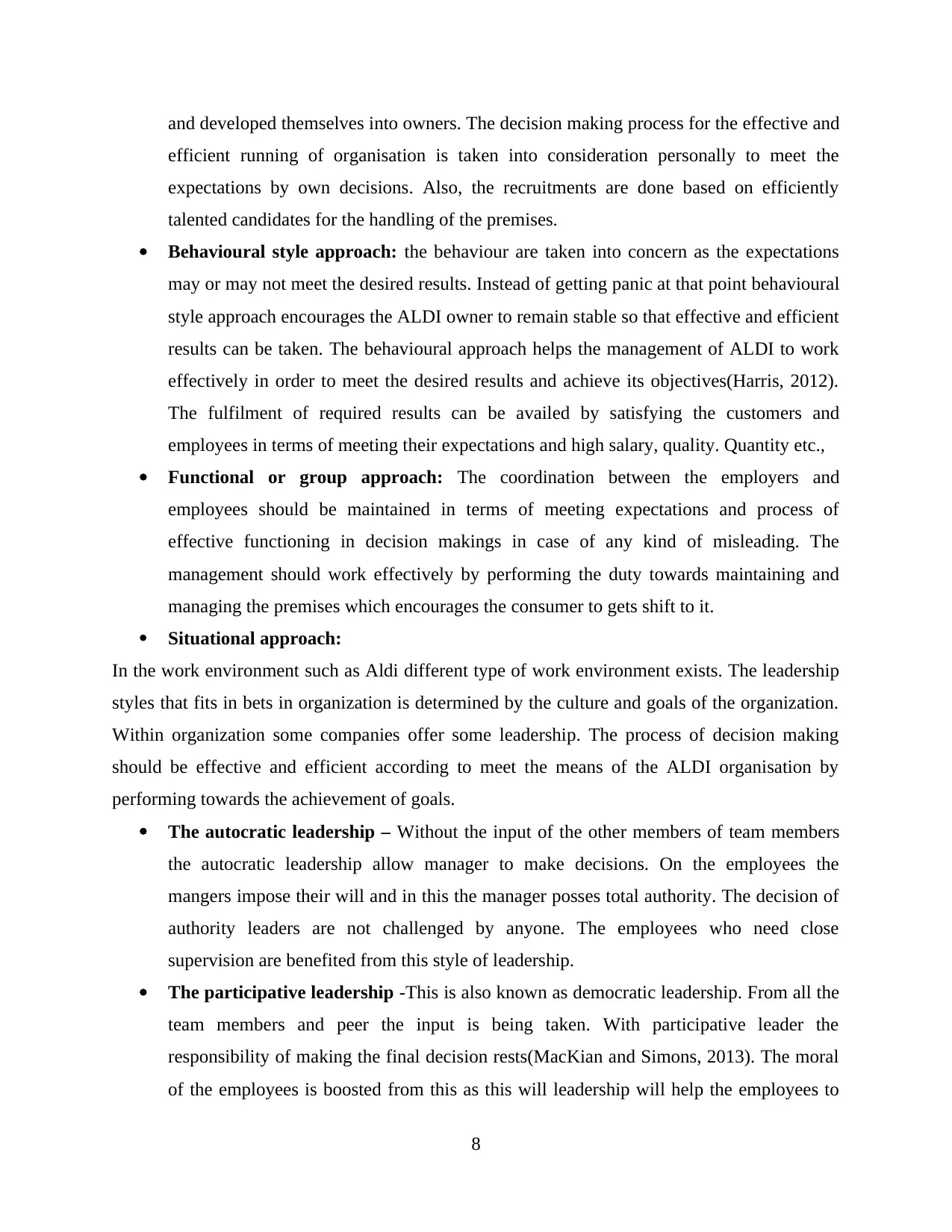
and developed themselves into owners. The decision making process for the effective and
efficient running of organisation is taken into consideration personally to meet the
expectations by own decisions. Also, the recruitments are done based on efficiently
talented candidates for the handling of the premises.
Behavioural style approach: the behaviour are taken into concern as the expectations
may or may not meet the desired results. Instead of getting panic at that point behavioural
style approach encourages the ALDI owner to remain stable so that effective and efficient
results can be taken. The behavioural approach helps the management of ALDI to work
effectively in order to meet the desired results and achieve its objectives(Harris, 2012).
The fulfilment of required results can be availed by satisfying the customers and
employees in terms of meeting their expectations and high salary, quality. Quantity etc.,
Functional or group approach: The coordination between the employers and
employees should be maintained in terms of meeting expectations and process of
effective functioning in decision makings in case of any kind of misleading. The
management should work effectively by performing the duty towards maintaining and
managing the premises which encourages the consumer to gets shift to it.
Situational approach:
In the work environment such as Aldi different type of work environment exists. The leadership
styles that fits in bets in organization is determined by the culture and goals of the organization.
Within organization some companies offer some leadership. The process of decision making
should be effective and efficient according to meet the means of the ALDI organisation by
performing towards the achievement of goals.
The autocratic leadership – Without the input of the other members of team members
the autocratic leadership allow manager to make decisions. On the employees the
mangers impose their will and in this the manager posses total authority. The decision of
authority leaders are not challenged by anyone. The employees who need close
supervision are benefited from this style of leadership.
The participative leadership -This is also known as democratic leadership. From all the
team members and peer the input is being taken. With participative leader the
responsibility of making the final decision rests(MacKian and Simons, 2013). The moral
of the employees is boosted from this as this will leadership will help the employees to
8
efficient running of organisation is taken into consideration personally to meet the
expectations by own decisions. Also, the recruitments are done based on efficiently
talented candidates for the handling of the premises.
Behavioural style approach: the behaviour are taken into concern as the expectations
may or may not meet the desired results. Instead of getting panic at that point behavioural
style approach encourages the ALDI owner to remain stable so that effective and efficient
results can be taken. The behavioural approach helps the management of ALDI to work
effectively in order to meet the desired results and achieve its objectives(Harris, 2012).
The fulfilment of required results can be availed by satisfying the customers and
employees in terms of meeting their expectations and high salary, quality. Quantity etc.,
Functional or group approach: The coordination between the employers and
employees should be maintained in terms of meeting expectations and process of
effective functioning in decision makings in case of any kind of misleading. The
management should work effectively by performing the duty towards maintaining and
managing the premises which encourages the consumer to gets shift to it.
Situational approach:
In the work environment such as Aldi different type of work environment exists. The leadership
styles that fits in bets in organization is determined by the culture and goals of the organization.
Within organization some companies offer some leadership. The process of decision making
should be effective and efficient according to meet the means of the ALDI organisation by
performing towards the achievement of goals.
The autocratic leadership – Without the input of the other members of team members
the autocratic leadership allow manager to make decisions. On the employees the
mangers impose their will and in this the manager posses total authority. The decision of
authority leaders are not challenged by anyone. The employees who need close
supervision are benefited from this style of leadership.
The participative leadership -This is also known as democratic leadership. From all the
team members and peer the input is being taken. With participative leader the
responsibility of making the final decision rests(MacKian and Simons, 2013). The moral
of the employees is boosted from this as this will leadership will help the employees to
8
Paraphrase This Document
Need a fresh take? Get an instant paraphrase of this document with our AI Paraphraser
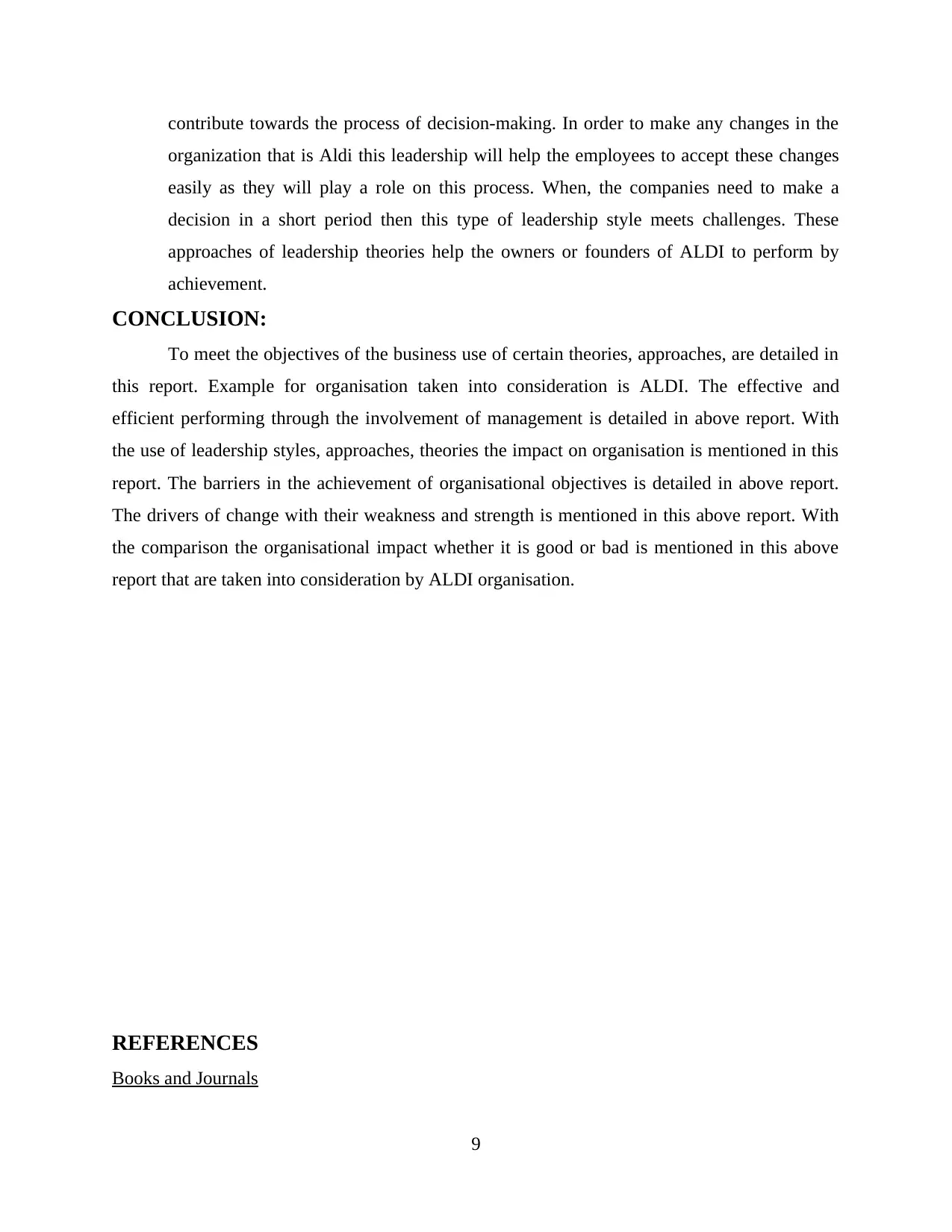
contribute towards the process of decision-making. In order to make any changes in the
organization that is Aldi this leadership will help the employees to accept these changes
easily as they will play a role on this process. When, the companies need to make a
decision in a short period then this type of leadership style meets challenges. These
approaches of leadership theories help the owners or founders of ALDI to perform by
achievement.
CONCLUSION:
To meet the objectives of the business use of certain theories, approaches, are detailed in
this report. Example for organisation taken into consideration is ALDI. The effective and
efficient performing through the involvement of management is detailed in above report. With
the use of leadership styles, approaches, theories the impact on organisation is mentioned in this
report. The barriers in the achievement of organisational objectives is detailed in above report.
The drivers of change with their weakness and strength is mentioned in this above report. With
the comparison the organisational impact whether it is good or bad is mentioned in this above
report that are taken into consideration by ALDI organisation.
REFERENCES
Books and Journals
9
organization that is Aldi this leadership will help the employees to accept these changes
easily as they will play a role on this process. When, the companies need to make a
decision in a short period then this type of leadership style meets challenges. These
approaches of leadership theories help the owners or founders of ALDI to perform by
achievement.
CONCLUSION:
To meet the objectives of the business use of certain theories, approaches, are detailed in
this report. Example for organisation taken into consideration is ALDI. The effective and
efficient performing through the involvement of management is detailed in above report. With
the use of leadership styles, approaches, theories the impact on organisation is mentioned in this
report. The barriers in the achievement of organisational objectives is detailed in above report.
The drivers of change with their weakness and strength is mentioned in this above report. With
the comparison the organisational impact whether it is good or bad is mentioned in this above
report that are taken into consideration by ALDI organisation.
REFERENCES
Books and Journals
9
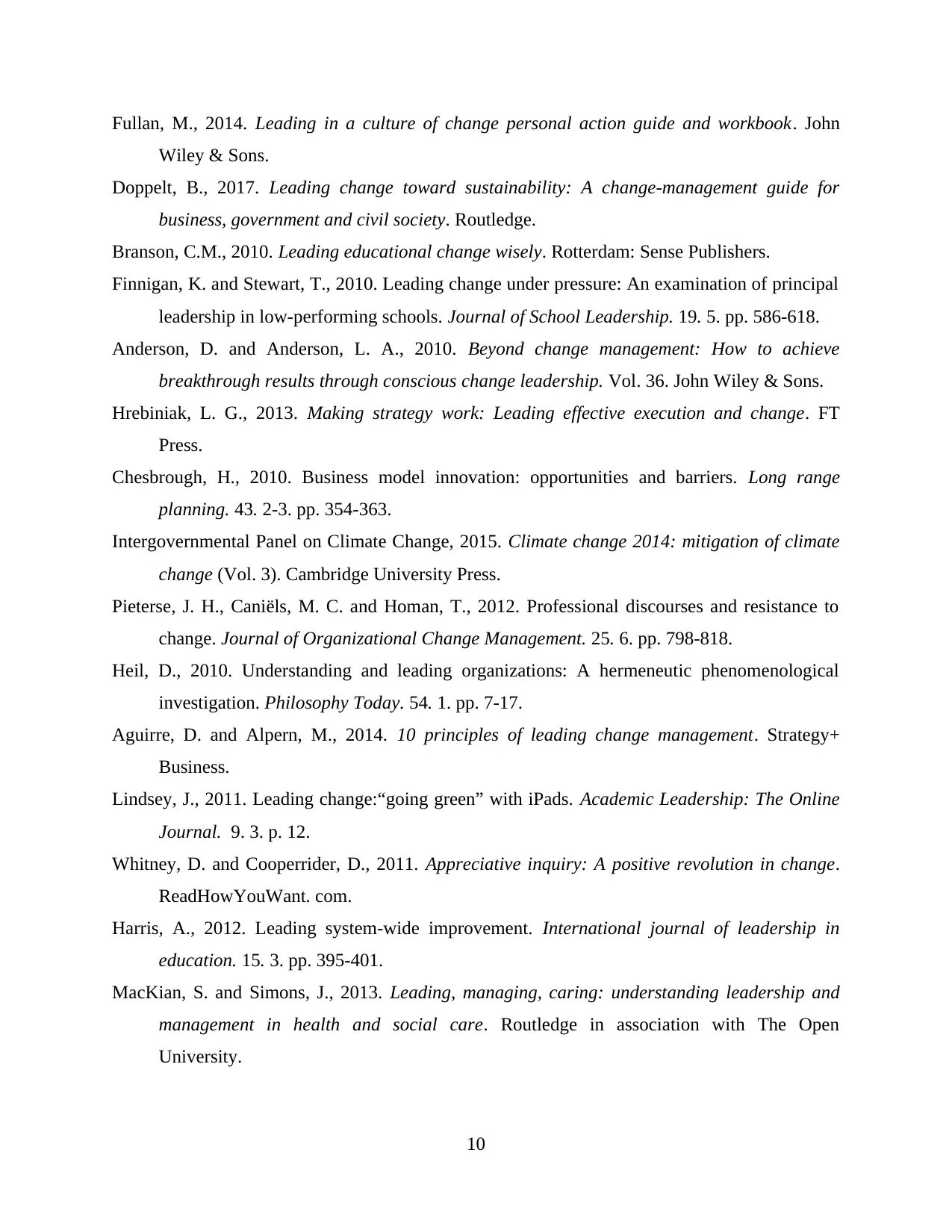
Fullan, M., 2014. Leading in a culture of change personal action guide and workbook. John
Wiley & Sons.
Doppelt, B., 2017. Leading change toward sustainability: A change-management guide for
business, government and civil society. Routledge.
Branson, C.M., 2010. Leading educational change wisely. Rotterdam: Sense Publishers.
Finnigan, K. and Stewart, T., 2010. Leading change under pressure: An examination of principal
leadership in low-performing schools. Journal of School Leadership. 19. 5. pp. 586-618.
Anderson, D. and Anderson, L. A., 2010. Beyond change management: How to achieve
breakthrough results through conscious change leadership. Vol. 36. John Wiley & Sons.
Hrebiniak, L. G., 2013. Making strategy work: Leading effective execution and change. FT
Press.
Chesbrough, H., 2010. Business model innovation: opportunities and barriers. Long range
planning. 43. 2-3. pp. 354-363.
Intergovernmental Panel on Climate Change, 2015. Climate change 2014: mitigation of climate
change (Vol. 3). Cambridge University Press.
Pieterse, J. H., Caniëls, M. C. and Homan, T., 2012. Professional discourses and resistance to
change. Journal of Organizational Change Management. 25. 6. pp. 798-818.
Heil, D., 2010. Understanding and leading organizations: A hermeneutic phenomenological
investigation. Philosophy Today. 54. 1. pp. 7-17.
Aguirre, D. and Alpern, M., 2014. 10 principles of leading change management. Strategy+
Business.
Lindsey, J., 2011. Leading change:“going green” with iPads. Academic Leadership: The Online
Journal. 9. 3. p. 12.
Whitney, D. and Cooperrider, D., 2011. Appreciative inquiry: A positive revolution in change.
ReadHowYouWant. com.
Harris, A., 2012. Leading system-wide improvement. International journal of leadership in
education. 15. 3. pp. 395-401.
MacKian, S. and Simons, J., 2013. Leading, managing, caring: understanding leadership and
management in health and social care. Routledge in association with The Open
University.
10
Wiley & Sons.
Doppelt, B., 2017. Leading change toward sustainability: A change-management guide for
business, government and civil society. Routledge.
Branson, C.M., 2010. Leading educational change wisely. Rotterdam: Sense Publishers.
Finnigan, K. and Stewart, T., 2010. Leading change under pressure: An examination of principal
leadership in low-performing schools. Journal of School Leadership. 19. 5. pp. 586-618.
Anderson, D. and Anderson, L. A., 2010. Beyond change management: How to achieve
breakthrough results through conscious change leadership. Vol. 36. John Wiley & Sons.
Hrebiniak, L. G., 2013. Making strategy work: Leading effective execution and change. FT
Press.
Chesbrough, H., 2010. Business model innovation: opportunities and barriers. Long range
planning. 43. 2-3. pp. 354-363.
Intergovernmental Panel on Climate Change, 2015. Climate change 2014: mitigation of climate
change (Vol. 3). Cambridge University Press.
Pieterse, J. H., Caniëls, M. C. and Homan, T., 2012. Professional discourses and resistance to
change. Journal of Organizational Change Management. 25. 6. pp. 798-818.
Heil, D., 2010. Understanding and leading organizations: A hermeneutic phenomenological
investigation. Philosophy Today. 54. 1. pp. 7-17.
Aguirre, D. and Alpern, M., 2014. 10 principles of leading change management. Strategy+
Business.
Lindsey, J., 2011. Leading change:“going green” with iPads. Academic Leadership: The Online
Journal. 9. 3. p. 12.
Whitney, D. and Cooperrider, D., 2011. Appreciative inquiry: A positive revolution in change.
ReadHowYouWant. com.
Harris, A., 2012. Leading system-wide improvement. International journal of leadership in
education. 15. 3. pp. 395-401.
MacKian, S. and Simons, J., 2013. Leading, managing, caring: understanding leadership and
management in health and social care. Routledge in association with The Open
University.
10
⊘ This is a preview!⊘
Do you want full access?
Subscribe today to unlock all pages.

Trusted by 1+ million students worldwide
1 out of 13
Related Documents
Your All-in-One AI-Powered Toolkit for Academic Success.
+13062052269
info@desklib.com
Available 24*7 on WhatsApp / Email
![[object Object]](/_next/static/media/star-bottom.7253800d.svg)
Unlock your academic potential
Copyright © 2020–2025 A2Z Services. All Rights Reserved. Developed and managed by ZUCOL.





